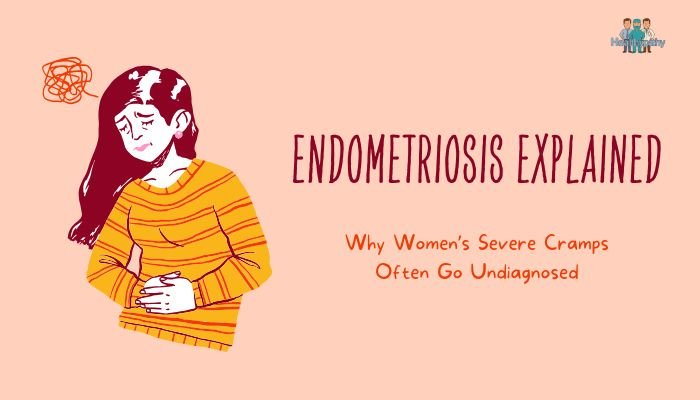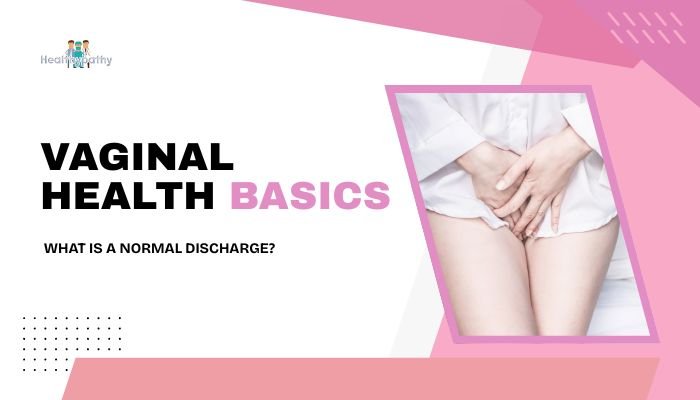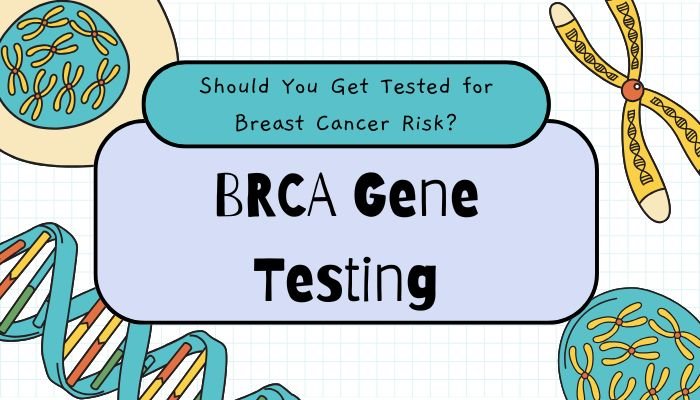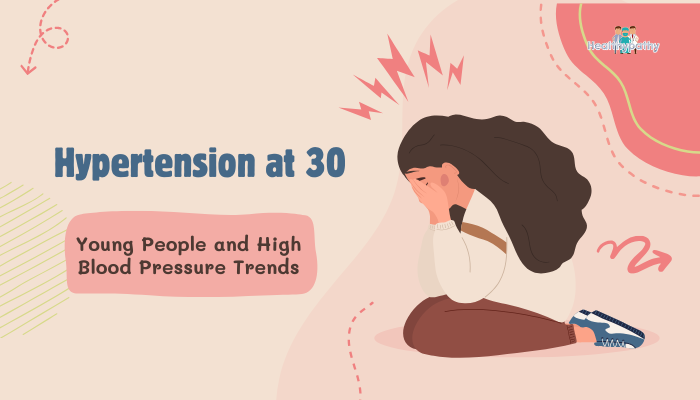Introduction
Endometriosis is a chronic condition that causes endometrial-like tissue to grow outside the uterus. This tissue can form on the ovaries, fallopian tubes, bowel, bladder, or other locations in the pelvic area. The condition often leads to severe cramps, pelvic pain, painful intercourse, and fertility problems. Some women notice intense menstrual pain that disrupts their work and personal life. Despite the significant impact on daily functioning, endometriosis commonly goes undiagnosed for many years.
Delayed recognition of endometriosis has multiple contributing factors. Many people assume painful cramps are normal, which causes them to minimize symptoms. There is also a tendency for society to overlook, dismiss, or normalize women’s pain. In medical settings, women with severe menstrual cramps may receive short-term pain relief without having a thorough evaluation. Meanwhile, the persistent pain can escalate, leading to further complications like adhesions, cysts, and organ involvement.
This article explains what endometriosis is, why it often remains undiagnosed, and how women can recognize and address symptoms earlier. It also discusses common treatment methods and potential lifestyle measures that can help. Understanding endometriosis is key to reducing diagnostic delays and improving the overall health of those affected.
Understanding Endometriosis
Endometriosis involves the growth of tissue that resembles the uterine lining (endometrium) outside the uterus. During the menstrual cycle, these tissues thicken and break down in response to hormonal changes, similar to the normal uterine lining. However, because the tissue is not located within the uterus, it cannot fully exit the body. This can cause internal bleeding, inflammation, and scar tissue formation.
The Role of the Endometrium
- The endometrium lines the inside of the uterus.
- Each month, it thickens in preparation for a potential pregnancy.
- If pregnancy does not occur, the endometrium sheds as menstrual flow.
In endometriosis, cells that mimic endometrial cells attach to structures outside the uterus. These cells respond to the same hormonal cues as the true endometrium. When it breaks down, the blood and tissue debris have nowhere to escape, triggering inflammation and pain.
Common Symptoms
- Painful menstrual cramps (dysmenorrhea). Many women describe these as extremely sharp or debilitating.
- Pain during or after intercourse. Sexual activity can aggravate inflamed tissue in the pelvic region.
- Chronic pelvic pain. Pain may be continuous or worsen during certain phases of the menstrual cycle.
- Bowel and urinary discomfort. Some individuals experience pain during bowel movements or urination, especially if the bowel or bladder are involved.
- Fatigue and general malaise. Chronic pain and hormonal fluctuations can influence energy levels.
- Infertility or challenges conceiving. Endometriosis can create structural or inflammatory issues in the reproductive tract.
The intensity of symptoms varies. Some people have mild discomfort, while others experience severe pain that interferes with daily activities. The extent of tissue growth does not always match symptom severity. A person with many lesions might have fewer symptoms than someone with fewer but more deeply penetrating lesions.
Why Diagnosis Is Often Delayed
Despite its prevalence, endometriosis frequently remains undetected for several years. Diagnostic delays increase the risk of complications and prolonged suffering.
Overlapping Symptoms
Endometiosis mimics conditions like pelvic inflammatory disease, irritable bowel syndrome, fibroids, or even pelvic muscle dysfunction. This overlap makes it more challenging for clinicians to isolate the cause without detailed imaging or direct visualization.
Cultural and Social Factors
Some cultures and social circles consider painful periods as a normal part of life. This can cause individuals to underreport symptoms, believing their experience is typical. When severe cramps are normalized, it becomes less likely for healthcare providers to explore conditions such as endometriosis in the early stages.
Clinical Tools and Challenges
A definitive endometriosis diagnosis usually involves:
- Imaging. Transvaginal or pelvic ultrasound can help identify ovarian endometriomas (also known as “chocolate cysts”) and other abnormalities.
- MRI. Magnetic resonance imaging can show more detailed structures in the pelvis.
- Laparoscopy. A minimally invasive procedure is used for direct visualization of lesions.
Many clinics may not have easy access to advanced imaging. In some cases, laparoscopy is delayed unless symptoms are extreme, which means early-stage endometriosis might go undiagnosed. Healthcare professionals may also look for classic markers, like visible lesions on ultrasound, but a clear ultrasound does not rule out smaller lesions.
Causes and Risk Factors
The exact cause of endometriosis remains under investigation. However, several theories and risk factors have gained recognition.
Theories of Pathogenesis
- Retrograde Menstruation: Menstrual blood flows back through the fallopian tubes, carrying endometrial cells into the pelvis.
- Cell Transformation: Hormones or immune factors transform peritoneal cells (lining of the abdominal cavity) into cells resembling the endometrium.
- Immune Dysregulation: The immune system fails to remove endometrial-like cells that exist outside the uterus.
No single theory explains all cases. In reality, endometriosis might result from a combination of hormonal, genetic, and immunological factors.
Hormonal Influences
Estrogen plays a significant role in the development and progression of endometriosis. This hormone:
- Encourages the growth and thickening of endometrial tissue.
- May increase the inflammatory response around lesions.
- Can stimulate the formation of new blood vessels that feed endometriotic tissue.
Women with higher levels of circulating estrogen or estrogen dominance might be more prone to endometriosis.
Types of Endometriosis
Endometriosis presents in different forms. Understanding these distinctions can help in planning treatment.
Superficial Peritoneal Lesions
- These are often small implants on the surface of the peritoneum or pelvic organs.
- They can cause irritation, inflammation, and pain.
Ovarian Endometriomas (Chocolate Cysts)
- These cysts contain thick, dark fluid made of old blood and tissue debris.
- They can enlarge and damage ovarian tissue, impacting fertility.
Deep Infiltrating Endometriosis
- The tissue invades deeper layers of the pelvic organs, sometimes beyond 5 millimeters.
- This form can lead to severe pain, organ dysfunction, and a higher risk of scarring.
Impact on Fertility
Endometriosis can make conception and a full-term pregnancy more difficult. Although many women with endometriosis have successful pregnancies, fertility rates are often lower. Some may require medical intervention.
Mechanisms of Infertility
- Distortion of Pelvic Anatomy: Large lesions or cysts can displace organs and block the fallopian tubes.
- Inflammation: Chronic inflammation can affect egg quality and the function of sperm and embryos.
- Impaired Ovulation: Hormonal imbalances related to endometriosis might disrupt normal ovulation.
- Scar Tissue (Adhesions): Fibrous bands can reduce the mobility of fallopian tubes or ovaries.
Treatment to Enhance Fertility
- Hormonal Therapies: Medications like gonadotropin-releasing hormone agonists may suppress lesions and help preserve fertility.
- Surgical Intervention: Surgical removal of endometrial lesions can improve the chances of conception.
- Assisted Reproduction: In vitro fertilization (IVF) may bypass some structural challenges by combining sperm and egg outside the body.
Each option has different success rates and side effects. Consulting a fertility specialist is a recommended step for those looking to conceive.
Treatment Approaches
Endometriosis treatment depends on symptom severity, desire for fertility, and overall health. Options often include a combination of medical, surgical, and supportive measures.
Medical Management
- Nonsteroidal Anti-Inflammatory Drugs (NSAIDs): These help manage mild to moderate pain.
- Hormonal Contraceptives: Birth control pills, patches, or vaginal rings can regulate hormonal fluctuations and reduce endometrial tissue growth.
- Progestin-Only Therapy: Progesterone-like medications may help shrink lesions.
- Gonadotropin-Releasing Hormone (GnRH) Agonists: These suppress estrogen production but can cause menopausal-like side effects.
- Aromatase Inhibitors: These lower estrogen levels in the body, slowing tissue growth.
Surgical Interventions
- Laparoscopic Excision or Ablation: Surgeons remove or burn away endometriotic lesions.
- Cystectomy for Endometriomas: Cysts on the ovaries are removed to restore normal ovarian function.
- Hysterectomy: Removal of the uterus (and sometimes the ovaries) may be considered in severe cases that do not respond to other treatments. However, this is typically the last resort when childbearing is no longer desired.
Pain Management
- Physical Therapy: Pelvic floor therapy can reduce muscle tension and pain.
- TENS (Transcutaneous Electrical Nerve Stimulation): Electrical impulses may alleviate pelvic pain.
- Nerve Block Injections: In specific cases, nerve blocks can disrupt the pain signals in the pelvis.
Complementary Measures
While medical and surgical treatments can address the underlying causes of endometriosis, certain lifestyle approaches may help improve daily functioning.
Nutritional Approaches
- Anti-Inflammatory Diet: Focus on fruits, vegetables, whole grains, and lean proteins. A balanced intake of these foods can reduce inflammation.
- Limit Potential Triggers: Some report improvement when limiting sources of saturated fats or refined sugars.
- Omega-3 Fatty Acids: Found in fish, nuts, and seeds, these may help reduce inflammatory responses in the body.
Exercise and Physical Therapy
- Gentle Exercises: Walking, light stretching, and low-impact workouts may increase blood flow and lessen pain.
- Pelvic Floor Muscle Exercises: A specialized physical therapist can design routines to reduce muscular tension.
Stress Reduction
- Mind-Body Techniques: Activities like breathing exercises may lower pain perception.
- Sleep Management: Adequate rest can improve overall well-being and hormone regulation.
- Supportive Counseling: Chronic pelvic pain can trigger emotional strain. Short-term counseling can help improve coping skills.
Supporting Emotional Health
Endometriosis can create mental and emotional challenges. Chronic pain, frustration with delayed diagnosis, and concerns about fertility can affect mood and relationships.
Dealing with Chronic Pain
- Cognitive Behavioral Therapy (CBT): Helps people adjust pain responses and adopt healthier coping mechanisms.
- Relaxation Techniques: Techniques such as simple guided relaxation or gradual muscle relaxation may diminish pain-related stress.
Joining Support Groups
- Peer Support: Sharing experiences with others who have endometriosis can reduce the sense of isolation.
- Online Communities: Many find practical advice in forums dedicated to endometriosis care.
Communication with Partners
- Open Discussions: Partners benefit from understanding that the pain is real and chronic.
- Practical Support: Partners can provide help with household tasks during flare-ups and encourage consistent treatment.
Long-Term Outlook
The long-term outlook for those with endometriosis varies based on lesion severity, response to treatment, and overall health status.
Monitoring for Recurrence
Endometriosis can recur even after successful treatment. Post-surgical recurrence rates vary, but hormonal management and consistent monitoring can mitigate these risks. Regular follow-up can identify regrowth or new lesions before they progress.
Personal Advocacy
- Track Symptoms: Keeping a diary of pain intensity, menstrual cycles, and related experiences can guide further medical consultations.
- Seek Specialist Care: A gynecologist or reproductive endocrinologist with endometriosis expertise can provide targeted treatment plans.
- Stay Informed: Ongoing research continuously updates recommendations and approaches.
Conclusion
Endometriosis is a common yet underdiagnosed condition that causes significant menstrual pain and, in some cases, fertility difficulties. It stems from the presence of endometrial-like tissue outside the uterus, which causes bleeding, inflammation, scarring, and chronic pain. Diagnosis is often delayed due to overlapping symptoms, social norms that dismiss severe cramps, and the need for specialized tools like laparoscopy to confirm the condition.
A range of treatments—from hormonal therapies to surgery—can help alleviate pain and improve quality of life. Complementary lifestyle changes, including anti-inflammatory dietary choices, controlled exercise, and stress-management strategies, may also provide relief. Women are encouraged to document and share their symptoms with a healthcare professional, especially when persistent pain disrupts daily life. Timely intervention can prevent complications and contribute to an improved long-term outcome.
References
- Giudice LC. Endometriosis. N Engl J Med. 2010;362(25):2389–2398.
- Bulun SE. Endometriosis. N Engl J Med. 2009;360(3):268–279.
- Fauconnier A, Chapron C. Endometriosis and pelvic pain: epidemiological evidence of the relationship and implications. Hum Reprod Update. 2005;11(6):595–606.
- Burney RO, Giudice LC. Pathogenesis and pathophysiology of endometriosis. Fertil Steril. 2012;98(3):511–519.
Meuleman C, Vandenabeele B, Fieuws S, Spiessens C, Timmerman D, D’Hooghe T. High prevalence of endometriosis in infertile women with normal ovulation and normospermic partners. Fertil Steril. 2009;92(1):68–74. - Kennedy S, Koninckx P, D’Hooghe T. Endometriosis. J Obstet Gynaecol Can. 2005;27(7):641–653.
- Vercellini P, Viganò P, Somigliana E, Fedele L. Endometriosis: pathogenesis and treatment. Nat Rev Endocrinol. 2014;10(5):261–275.
Practice Committee of the American Society for Reproductive Medicine. Endometriosis and infertility: a committee opinion. Fertil Steril. 2012;98(3):591–598. - Agarwal SK, Foster WG. Environmental contaminants and endometriosis. Semin Reprod Med. 2011;29(3):210–227.
- Fedele L, Parazzini F, Bianchi S, Arcaini L. Stage and localization of pelvic endometriosis and pain. Fertil Steril. 1990;53(1):155–158.
- Falcone T, Lebovic DI. Clinical management of endometriosis. Obstet Gynecol. 2011;118(3):691–705.
- Lukic A, Guerby P, Suciu N, Pontis A, Ayoubi JM, Alessandri F. Endometriosis and infertility: a comprehensive review. J Gynecol Obstet Hum Reprod. 2020;49(8):101883.







